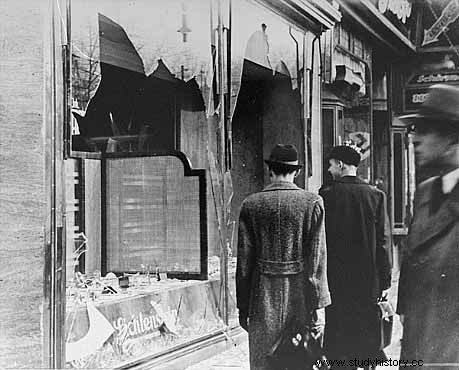Jews are rejected by the German Reich. They are stigmatized by the Civil Service Restoration Act of 1933, which prohibits them from exercising in the civil service and even more so by the Nuremberg Laws, which deprive them of German nationality, prohibit them from marital and extramarital relations. with citizens and forces them to show that they are Jewish.
In 1937, the film The Eternal Jew further stirs up public opinion against the Jews.
On November 7, a Polish Jew kills Ernst von Rath, a Nazi diplomat in Paris. This event serves as a catalyst for hatred against Jews. Goebbels, following this affair, encouraged pogroms (a word of Russian origin which means to destroy, to pillage) under the orders of Adolf Hitler, Chancellor of the Reich.
November 9 and 10, 1938

Characters
Ernst von Rath
Joseph Goebbels
Adolf Hitler
Rudolf Hess
Procedure
Two days later, on the evening of November 9, Goebbels announced the murder of the diplomat, while specifying that anti-Jewish riots had broken out in the country and that Hitler had decided not to repress them. riots are only the result of undirected and spontaneous behavior. Kristallnacht was however well orchestrated by the authorities. The preparation of the concentration camps during the months which preceded the event confirms this thesis. the country. The order is given to the Gestapo to let it go and preserve itself for mass arrests of thousands of people the next day. The population fervently follows the movement and does not hesitate to humiliate the people concerned:the Jews are forced to s to kneel, to dance, to sing, to kiss the ground, to make them read passages from Mein Kampf and this in addition to the violence they suffer. Places of worship, cemeteries, apartments, shops are desecrated and destroyed (hence the name Kristallnacht, because of the bursting of the windows). It is the people in particular who carry out most of the violence against the Jews, as well as organizations like the Hitler Youth.
Consequences
Between 20 and 30,000 Jews were deported to concentration camps, about a hundred were murdered, others preferred to commit suicide and people were raped. 7,000 businesses were destroyed, as were 200 places of worship. In Germany, no protest emerged publicly. We have the impression of a population that willingly accepts events.
The indignation is unanimous abroad, but the reactions are not very effective:the United States refuses a large part of the requests for asylum of the Jews, just like Great Britain, which closes the access to Palestine. /P>
These riots violently tarnish the image of Nazi Germany:it is therefore difficult to find this sympathetic regime.
